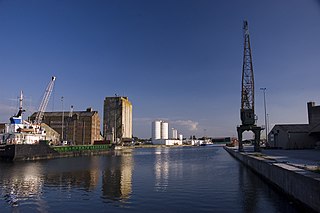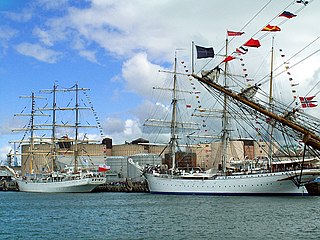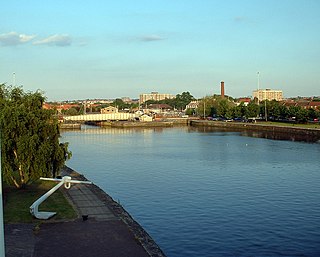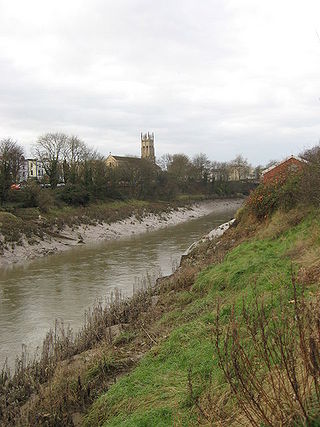
A floating dock, floating harbour or wet dock is a dock alongside a tidal waterway which maintains a 'constant' level, despite the changing tides.

A floating dock, floating harbour or wet dock is a dock alongside a tidal waterway which maintains a 'constant' level, despite the changing tides.
At the most basic level, a floating dock is isolated from tidal water by a lock gate, at least, although in many dock systems the entrance is more complex than this.

The first wet dock was Howland Great Wet Dock or Greenland Dock, built in London at the end of the 17th century. This was not a commercial dock and had no warehouses, but was intended solely for ship replenishment and refitting. [1]
In 1715 the first commercial wet dock, Liverpool's Old Dock, opened. [2] Early docks were of simple construction: a single lock gate isolating them from the tidal water. The gates were opened during the last hour [or two] of the rising tide, giving a short window of opportunity to let ships in on the rise and releasing outgoing ships while the tide was on the turn. The gates were closed at top of tide to maintain levels within the dock. Although this short opening period may have seemed disruptive, any attempt at longer opening might allow dock water-level to fall with the ebbing tide thus interfering with the wharf-side level of every ship in the basin.
A half tide dock is a partially tidal dock. They need have no gate, but as the tide ebbs a raised sill or weir on the floor of the dock prevents the level dropping below a certain point, meaning that the ships in the dock remain afloat, although they still fall with the first ebb of the tide. Half tide docks were only useful for ships of shallow draught, in areas with a large tidal range. The tide must rise sufficiently to give them a clear passage over the raised sill.
In 1775 Hull's Old Dock was opened. This was the first commercial floating dock, isolated by a lock rather than a single lock gate. This allowed the dock's water level to be maintained and, more importantly, it increased the time for which tidal access was possible. However the lock was only 121 ft long and this limited the number of ships passing through it. [3]
One of the first large fully floating docks was that of Bristol's Floating Harbour, built in 1809 to a plan by William Jessop. [4] This involved the diversion of the River Avon (Bristol) away from its previous route through the harbour and into a new channel at the New Cut. Entrance to the harbour was now gained through an entrance basin, at what is now Cumberland Basin. [5] Although linked by locks to the harbour and the river, the intention was that the basin would itself be used as an entrance lock: rather than locking each ship through one-by-one, ships could wait for the tide inside the basin and then the outer lock gates could both be opened allowing all to leave and arrive together. For a port with such a convoluted and tide-dependent approach as Bristol's, any easing of access was valuable.
As the harbour now need never be connected directly to the tidal waters, its water level could be held constant, without even the small variation of the hours around high tide. At Bristol, Jessop controlled the height of the harbour water by a broad weir, built as a dam across the previous route of the river. Levels were maintained by the flow of the small River Frome which still flowed into the harbour. [5]

As one of the first industrialised ports, Liverpool was at the forefront of dock development from the early 18th century. A network of inter-linked docks developed along the length of the River Mersey shoreline. These were floating docks, with access through a number of tidal basins and half tide docks. Ships could move through the interlinked docks 24 hours a day without moving into the tidal River Mersey, which would necessitate a pilot.

Floating docks are generally maintained at a level at least as high as the highest tide. Apart from any considerations of navigation, lock gates are usually arranged as a chevron. [note 1] and can only hold back higher water in one direction, which must always be from within the dock. A small but significant example of this is the locking system on the River Darent in Dartford, now in restoration and which were fully operational between 1899 and 1983.
Maintaining this higher level requires a supply of water. In some cases this is available from a river flowing into the harbour. This was the case for Bristol, at least initially, with the River Frome. Where there was no such river source, a mechanical pumping, or impounding, station was constructed. Liverpool's northern docks were served by one at Huskisson Dock and one on the opposite side of the Mersey for Wallasey Dock.
Bow Locks in East London has used a bi-directional system since the year 2000 permitting boats to transfer between the tidal Bow Creek and Limehouse Cut. Bow Locks permits transfer near top of tide whether it be neap or spring. Generally inbounds enter on the rise and outbounds on the fall. In practical use, the operation of Bow Locks is tightly controlled by the duty lock-keeper as every tide is different.

The River Avon is a river in the southwest of England. To distinguish it from a number of other rivers of the same name, it is often called the Bristol Avon. The name 'Avon' is loaned from an ancestor of the Welsh word afon, meaning 'river'.

The Bridgwater and Taunton Canal is a canal in the south-west of England between Bridgwater and Taunton, opened in 1827 and linking the River Tone to the River Parrett. There were a number of abortive schemes to link the Bristol Channel to the English Channel by waterway in the 18th and early 19th centuries. These schemes followed the approximate route eventually taken by the Bridgwater and Taunton Canal, but the canal was instead built as part of a plan to link Bristol to Taunton by waterway.

The River Mersey is a major river in North West England. Its name derives from Old English and means "boundary river", possibly referring to its having been a border between the ancient kingdoms of Mercia and Northumbria. For centuries it has formed part of the boundary between the historic counties of Lancashire and Cheshire.

The word dock in American English refers to one or a group of human-made structures that are involved in the handling of boats or ships. In British English, the term is not used the same way as in American English, it is used to mean the area of water that is next to or around a wharf or quay. The exact meaning varies among different variants of the English language.

Bristol Harbour is the harbour in the city of Bristol, England. The harbour covers an area of 70 acres. It is the former natural tidal river Avon through the city but was made into its current form in 1809 when the tide was prevented from going out permanently. A tidal by-pass was dug for 2 miles through the fields of Bedminster for the river, known as the "River Avon New Cut", "New Cut", or simply "The Cut". It is often called the Floating Harbour as the water level remains constant and it is not affected by the state of the tide on the river in the Avon Gorge, The New Cut or the natural river southeast of Temple Meads to its source.

Sharpness is an English port in Gloucestershire, one of the most inland in Britain, and eighth largest in the South West England region. It is on the River Severn at grid reference SO669027, at a point where the tidal range, though less than at Avonmouth downstream, is still large.

Gladstone Dock is a dock on the River Mersey, England, and part of the Port of Liverpool. It is situated in the northern dock system in Bootle. The dock is connected to Seaforth Dock to the north and what remains of Hornby Dock to the south. Part of Liverpool Freeport, Gladstone Dock is operated by the Mersey Docks and Harbour Company.

Sandon Half Tide Dock is a half tide dock on the River Mersey, England, and part of the Port of Liverpool. It is situated in the northern dock system in Kirkdale, connected to Huskisson Dock to the north, Wellington Dock to the east and Bramley-Moore Dock to the south. Sandon Dock was situated to the north of Wellington Dock and was accessible via Sandon Half Tide Dock.

The Old Dock, originally known as Thomas Steers' dock, was the world's first commercial wet dock. The 3+1⁄2 acres (1.4 ha) dock was built on the River Mersey in Liverpool, England, starting in 1710 and completed in 1716. A natural tidal pool off the River Mersey, which probably gave its name to Liverpool centuries earlier, was partially filled and locked in from the river with quay walls erected.
A half tide dock is a partially tidal dock. Typically the dock is entered at high tide. As the tide ebbs a sill or weir prevents the level dropping below a certain point, meaning that the ships in the dock remain afloat, although they still rise and fall with the tides above this. Half tide docks are particularly useful in areas with a large tidal range.

City Mill River is part of the Bow Back Rivers in London, England. It formerly fed City Mill, used for the production of chemicals in the late nineteenth and early twentieth centuries. In the 1930s, the mill was removed and the river was isolated from the tides by the construction of locks at both ends. City Mill Lock, at the southern end, has been refurbished and reopened in 2010.

Spike Island is an inner city and harbour area of the English port city of Bristol, adjoining the city centre. It comprises the strip of land between the Floating Harbour to the north and the tidal New Cut of the River Avon to the south, from the dock entrance to the west to Bathurst Basin in the east. The island forms part of Cabot ward. The area between the Docks and New cut to the east of Bathurst Basin is in the neighbourhoods of Redcliffe and St Philip's Marsh.

Netham Lock is the point at Netham in Bristol at which boats from the River Avon, acting as part of the Kennet and Avon Canal, gain access to Bristol's Floating Harbour.

The Cumberland Basin is the main entrance to the docks of the city of Bristol, England. It separates the areas of Hotwells from the tip of Spike Island.

The Underfall Yard is a historic boatyard on Spike Island serving Bristol Harbour in England.

Bromley Stop Lock was a lock on the Limehouse Cut in the London Borough of Tower Hamlets that was situated near the junction of Limehouse Cut and the River Lee Navigation by Bow Locks.

Bathurst Basin is a small triangular basin adjoining the main harbour of the city of Bristol, England. The basin takes its name from Charles Bathurst, who was a Bristol MP in the early 19th century.

The New Cut is an artificial waterway which was constructed between 1804 and 1809 to divert the tidal river Avon through south and east Bristol, England. This was part of the process of constructing Bristol's Floating Harbour, under the supervision of engineer William Jessop. The cut runs from Totterdown Basin at the eastern end of St Phillip's Marsh, near Temple Meads, to the Underfall sluices at Rownham in Hotwells and rejoining the original course of the tidal Avon.

A branch dock is a dock that forms part of a large harbour system of interlinked docks.

A caisson is a form of lock gate. It consists of a large floating iron or steel box. This can be flooded to seat the caisson in the opening of the dock to close it, or pumped dry to float it and allow it to be towed clear of the dock.